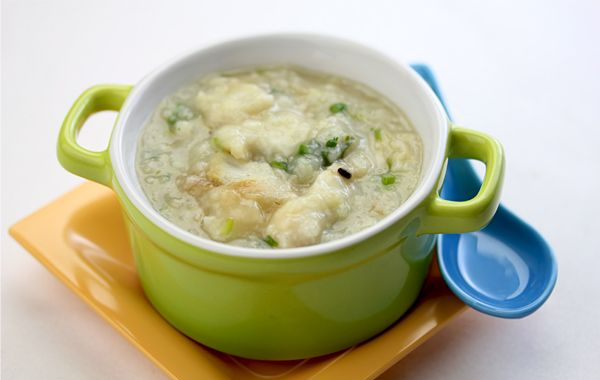Cháo cá (Vietnamese for fish congee) is Aria’s favorite dish these days. At one and a half years old now, she’s able to eat pretty much anything and everything. But don’t be fooled by its appearance; rice congee isn’t only meant for babies. Cháo is a very popular meal in Asia; I personally love it too.
In this version of congee I cook rice in fish stock until it becomes a thickened soup. I like to make small portions at a time by adding thinly sliced white flaky fish, ginger, onions and cilantro at the last minute. The key to flavorful fish congee is to use the freshest products available.
1. Info for Chao Ca Recipe (Fish Congee)
- Cook Time: unavailable
- Total Time: unavailable
- Servings: 8
- Calories: unavailable
2. Ingredients for Chao Ca Recipe (Fish Congee)
- 6¼ to 6½ quarts fish stock
- 2 whole catfish fillets (Swai fillets); any white flaky fish would work
- 3 yellow onions (1 whole, 2 thinly sliced)
- 1 (6-inch) chunk fresh ginger
- 2 daikon radishes, trimmed and peeled
- 2 tablespoons canola oil
- 3 cloves garlic, finely minced
- 2 teaspoons kosher salt, if the fish stock is already seasoned, to taste
- 1 chunk rock sugar (about 2 ounces) or (3 tablespoons granulated sugar), to taste
- 2 cups broken rice (see tips)
- 3 tablespoons cilantro, finely chopped
- 3 tablespoons green onions, chopped
- 1½ teaspoons black pepper, freshly cracked
3. Directions:
3.1 Prepping the ginger
Wash the whole unpeeled ginger and remove any dirt; pat dry. Cut off about 2 inches of the ginger root. Peel the cut piece with a paring knife, thinly slice it, then cut into long matchsticks. Set aside.
Bruise the rest of the ginger using a mallet to loosen the flesh and help release its flavor.
3.2 For the fish stock
Wash and rinse the broken rice thoroughly in several water baths. Unlike basmati rice, no soaking time is needed. Drain as much water as possible.
Fill a stockpot with the fish stock. Bring to a boil. Using a fine mesh strainer, skim the impurities rising to the surface of the broth. Once the stock is free from any impurities, lower the heat. Reserve about ½ cup and set aside.
To the same stock pot, add bruised ginger, fresh daikon and the whole yellow onion. Bring the liquid back to a gentle boil, then lower the heat to a bubbly simmer. Balance the flavor with more salt and sugar, if necessary.
Heat the oil in a medium, non-stick saucepan. Add thinly sliced onions. Cook over medium-low heat for about 10-15 minutes, stirring frequently to prevent the onions from burning, until the color is evenly golden brown. Transfer the onions to a plate, leaving about 2 teaspoons of onions in the saucepan.
Add ½ cup rice to the saucepan. The oil should coat all the grains. Add 2 cups of boiling-hot fish stock and stir occasionally. Bring the liquid back to a boil, then immediately lower the heat to a gentle boil. Cook until the broth thickens like porridge. Adjust seasoning.
3.3 Prepping the slices of fish
Make sure the fish is very cold (you could place the whole piece of fish in the freezer for about 30 minutes). Using a sharp knife, cut paper-thin slices. Sprinkle with black pepper.
3.4 Preparing cháo cá
Note: The key to a successful outcome is to prepare the bowls individually (no more than 2 servings at a time).
Into a separate saucepan, transfer the equivalent of 2 servings of rice porridge. Add a few ginger matchsticks, green onions and cilantro. Depending on the consistency you like, you could add more of the reserved fish stock to thin out the soup. Bring to a full boil one more time, then add about 4 tablespoons of the sliced fish. As soon as the fish becomes opaque in the broth, sprinkle with more freshly cracked pepper.
Serve immediately. You could drizzle the top with a little nuoc mam (fish sauce) if you like.
Repeat the same procedure for the next servings.
Bon appétit!
4. Tips and advices:
- Coating the individual grains of rice in oil prevents them from sticking to one another.
- Daikon (cu cai trang in Vietnamese) is an Asian radish that looks like a large white carrot. I use this root a lot for making broth.
- Com tam is a Vietnamese specialty rice. It translates to “broken rice”. My favorite brand is Ba Co Gai (Three Ladies). You can find it in most Asian stores. You can find rock sugar in Asian stores. You could also use granulated sugar instead.
- When you’re ready to serve, drizzle a few tablespoons of fish sauce (nuoc mam in Vietnamese). It gives a little brininess to the dish.
- For added crunch, you could top the soup with fresh bean sprouts right before serving.

